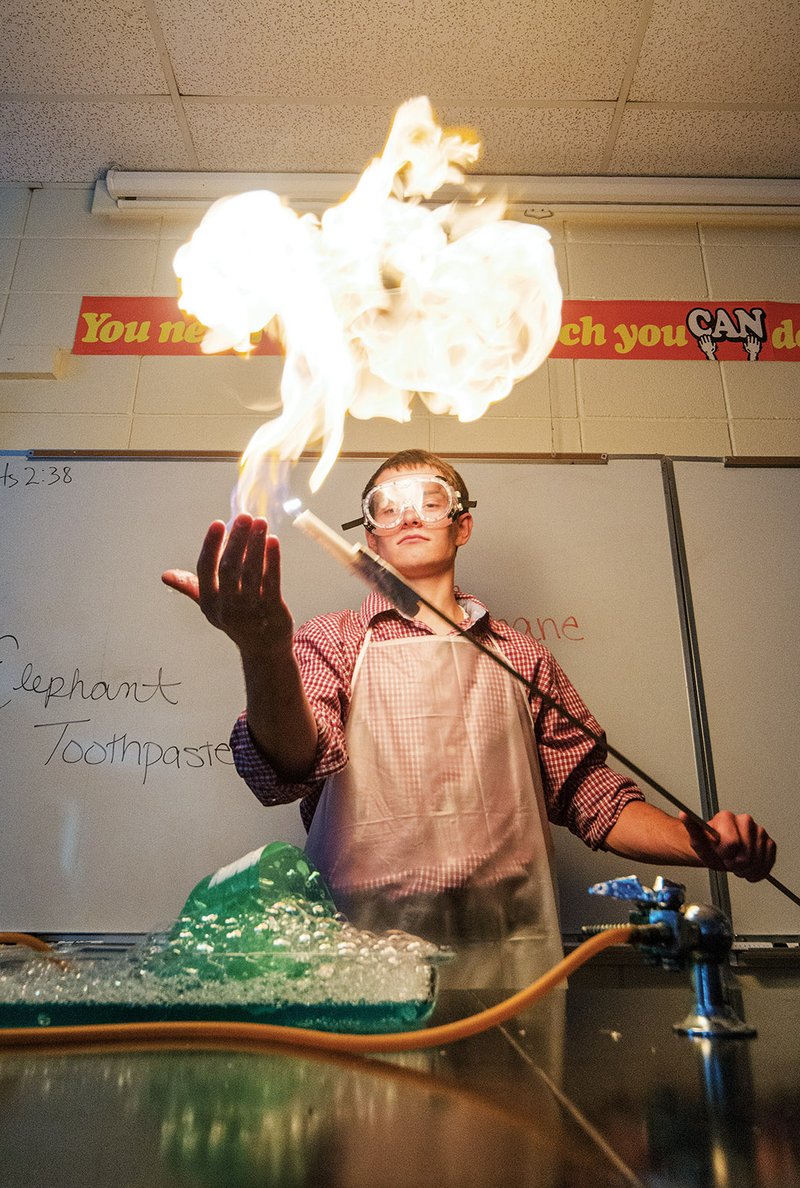Teachers and administrators generally frown upon students throwing flames at the classroom ceiling or blowing up gummy bears, but sometimes the rules can be bent in the name of science.
Four seniors at Harding Academy have been working on eye-catching science demonstrations as part of the UTeach Arkansas Scholarship Contest, and with a 15-second online video, they each have a chance to win $5,000 in tuition and college materials.
The UTeach program started in 1997 at the University of Texas at Austin to prepare secondary science, math and computer science teachers. The program is currently active in 40 universities in 19 states with more than 6,700 students and more than 2,000 graduates focusing on STEM — science, technology, engineering or math — education.
Gail Hughes, professor of educational leadership at the University of Arkansas at Little Rock, said teachers with math and science degrees are in high demand in the state, and training new teachers to fill that role is important for schools across Arkansas.
“UTeach programs in Arkansas are growing because they provide the best of both worlds — a degree and a teaching license in four years,” she said. “Graduates emerge with valuable skills sought by every industry and an opportunity to make a lasting impact in the classroom and beyond.”
UTeach Arkansas started in the fall 2012 semester at the University of Arkansas at Fayetteville, the University of Arkansas at Little Rock and the University of Central Arkansas, but this is the first year for this particular scholarship competition, said Lisa Palacios, assistant dean of enrollment management for UALR.
“The goal [of the scholarship contest] is truly to provide more information to high school students, teachers and their parents on the benefits of a teacher-preparation degree in science and math,” Palacios said. “It is a viable career option for prospective students and a high-need area in the state of Arkansas.”
The scholarship contest is for high school seniors. By entering a 15-second video that demonstrates a STEM concept, the students are eligible to win one of three scholarship packages, each of which includes a $2,500 tuition credit at a participating UTeach Arkansas university, a laptop, a graphing calculator and a $750 book voucher.
The four students from Harding Academy competing for the scholarship packages — Ross Eichhorn, Olivia Ballinger, Seth Klein and Taylor Wilkins — are in Tina Pugh’s honors chemistry class. Two have already submitted their entries for the contest, and the other two are still perfecting their demonstrations.
Ross has already submitted his video, in which he lit bubbles made with methane gas on fire, once with the bubbles flying toward the ceiling and once while the bubbles were still on his hand. With a combination of Dawn dishwashing liquid, glycerin and bubble mix, Ross used a 2-liter bottle with the top cut off as a funnel and hooked it up to the methane-gas hose. After getting some of the soap mix on the bottle, he made large bubbles and put a match to them as they floated toward the ceiling.
“It’s got a definite ‘wow factor’ to it,” Ross said. “Lighting things on fire — a lot of people like that.”
He plans to study cellular and molecular biology as an undergraduate student to prepare for a science-related graduate program.
Taylor has also submitted her video, in which she “sacrificed a gummy bear” for a neat effect. For her video, she heated up 7 grams of sodium chlorate in a test tube and then, once it was properly melted, added a gummy bear. Once the sugar in the gummy bear reacted with the sodium chlorate, an exothermic reaction was produced that resembled a rocket.
“It’s cool because it has fire,” she said. “But I really like it because something you have around the house like a gummy bear can produce rocket-like reactions in the test tube.”
Taylor said she plans to study biology and chemistry in college with the goal of becoming a dermatologist and plastic surgeon.
Olivia’s demonstration is called “elephant toothpaste.” She mixes hydrogen peroxide, Dawn dishwashing liquid and food coloring in a large flask, then adds sodium iodine to create a reaction. That reaction is colorful foam that shoots out of the top of the flask, mimicking a large tube of toothpaste. She is working to get the maximum reaction for her video entry.
“I like that you can make it your own,” she said. “You can make it many different ways. Some people do it at home with yeast. I tried that, but I didn’t like the results because they weren’t as strong.”
Olivia said she plans to pursue a career either teaching STEM-related classes or going into dentistry.
Seth’s demonstration shows how various salts produce different-colored flames. He lined up rows of sodium chloride, potassium chloride, copper chloride, lithium chloride and strontium chloride and soaked the rows with methanol. Connecting all of the rows with a line of methanol on the table, Seth puts a lighter to the line, and it spreads to each row of salt, creating different colors. The reactions sometimes do not light at the same time or intensity, which is why he is still working on his video entry.
“Sometimes in the lab when you’re separating chemicals, you can’t really tell one white rocklike substance from another white rocklike substance,” he said. “One day, someone decided, ‘Hey! We should burn them and see what color they are.’”
Seth plans to pursue a career in engineering, but he has not decided if he wants to study mechanical, computer or electrical engineering.
The entry period for the scholarship contest runs until Nov. 30, and the three winners will be announced in January. For more information about the contest or UTeach Arkansas, visit www.uteacharkansas.org.
Staff writer Angela Spencer can be reached at (501) 244-4307 or aspencer@arkansasonline.com.
